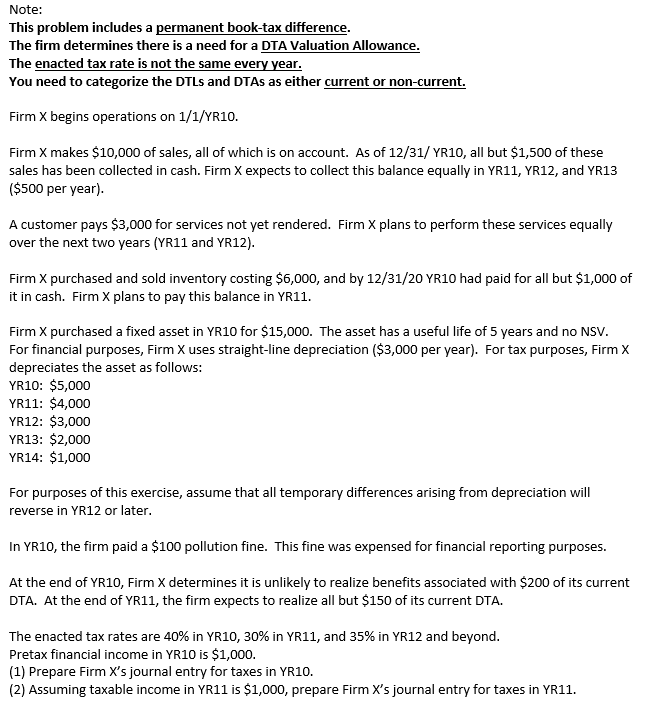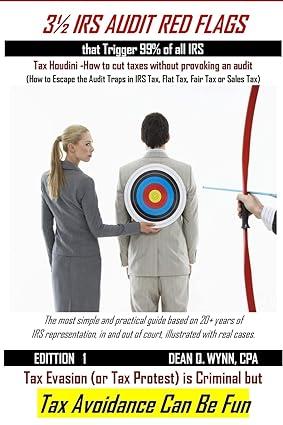Steps Please

Note: This problem includes a permanent book-tax difference. The firm determines there is a need for a DTA Valuation Allowance. The enacted tax rate is not the same every year. You need to categorize the DTLs and DTAs as either current or non-current. Firm X begins operations on 1/1/YR10. Firm X makes $10,000 of sales, all of which is on account. As of 12/31/ YR10, all but $1,500 of these sales has been collected in cash. Firm X expects to collect this balance equally in YR11, YR12, and YR13 ($500 per year). A customer pays $3,000 for services not yet rendered. Firm X plans to perform these services equally over the next two years (YR11 and YR12). Firm X purchased and sold inventory costing $6,000, and by 12/31/20 YR10 had paid for all but $1,000 of it in cash. Firm X plans to pay this balance in YR11. Firm X purchased a fixed asset in YR10 for $15,000. The asset has a useful life of 5 years and no NSV. For financial purposes, Firm X uses straight-line depreciation ($3,000 per year). For tax purposes, Firm X depreciates the asset as follows: YR10: $5,000 YR11: $4,000 YR12: $3,000 YR13: $2,000 YR14: $1,000 For purposes of this exercise, assume that all temporary differences arising from depreciation will reverse in YR12 or later. In YR10, the firm paid a $100 pollution fine. This fine was expensed for financial reporting purposes. At the end of YR10, Firm X determines it is unlikely to realize benefits associated with $200 of its current DTA. At the end of YR11, the firm expects to realize all but $150 of its current DTA. The enacted tax rates are 40% in YR10, 30% in YR11, and 35% in YR12 and beyond. Pretax financial income in YR10 is $1,000. (1) Prepare Firm X's journal entry for taxes in YR10. (2) Assuming taxable income in YR11 is $1,000, prepare Firm X's journal entry for taxes in YR11. Note: This problem includes a permanent book-tax difference. The firm determines there is a need for a DTA Valuation Allowance. The enacted tax rate is not the same every year. You need to categorize the DTLs and DTAs as either current or non-current. Firm X begins operations on 1/1/YR10. Firm X makes $10,000 of sales, all of which is on account. As of 12/31/ YR10, all but $1,500 of these sales has been collected in cash. Firm X expects to collect this balance equally in YR11, YR12, and YR13 ($500 per year). A customer pays $3,000 for services not yet rendered. Firm X plans to perform these services equally over the next two years (YR11 and YR12). Firm X purchased and sold inventory costing $6,000, and by 12/31/20 YR10 had paid for all but $1,000 of it in cash. Firm X plans to pay this balance in YR11. Firm X purchased a fixed asset in YR10 for $15,000. The asset has a useful life of 5 years and no NSV. For financial purposes, Firm X uses straight-line depreciation ($3,000 per year). For tax purposes, Firm X depreciates the asset as follows: YR10: $5,000 YR11: $4,000 YR12: $3,000 YR13: $2,000 YR14: $1,000 For purposes of this exercise, assume that all temporary differences arising from depreciation will reverse in YR12 or later. In YR10, the firm paid a $100 pollution fine. This fine was expensed for financial reporting purposes. At the end of YR10, Firm X determines it is unlikely to realize benefits associated with $200 of its current DTA. At the end of YR11, the firm expects to realize all but $150 of its current DTA. The enacted tax rates are 40% in YR10, 30% in YR11, and 35% in YR12 and beyond. Pretax financial income in YR10 is $1,000. (1) Prepare Firm X's journal entry for taxes in YR10. (2) Assuming taxable income in YR11 is $1,000, prepare Firm X's journal entry for taxes in YR11







